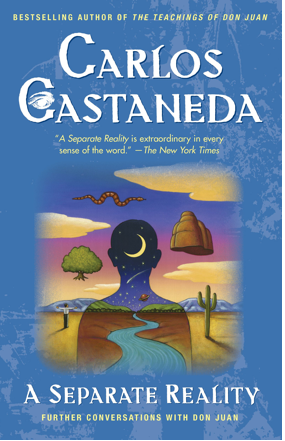Carlos Castaneda, A Separate Reality
reviewed by Danielle L. Parker

A Separate Reality Publisher: Washington Square Press Reissue edition (August 1, 1991) Length: 272 pages ISBN: 0671732498; 978-0671732493 |
The Carlos Castaneda books have floated around colleges for years, and for all I know, still do. A fellow student I can no longer remember pressed the series on me and insisted I read it. I read just enough to think, “This is weird,” and pass the dog-eared copies on.
Not to someone in my set, though. The group I associated with had one goal. By hook or crook, claw and struggle, weekends lost to study and romances forgone, we would forge a living. We had no time for silly stuff. The traditional wild-side college experimentation passed us by. None of us were going back home.
A Separate Reality turned up recently in the thrift store I browse for books. I held the battered copy in my hands and thought, “Hey... guess I can finish it. What will I think of it now? Is it still weird?”
For those who don’t know the history, Castaneda was an anthropologist who gave up scientific distance. Instead, he immersed himself in his subject. Castaneda became the apprentice of a Yaqui Indian brujo, a self-described sorcerer.
If you ever wanted a myopic view of how a shaman is born, this is it. The works are most famous for Castaneda’s flights on the wings of various psychotropic plants. Peyote, jimson weed, datura and the other hallucinogens used would have terrified us just to think about.
A Separate Reality is Don Juan’s attempt to teach his apprentice to “see.” Don Juan’s thesis is the way we perceive the world is but one limited way of seeing. Poe said it best: “a dream within a dream.” Don Juan uses hallucinogenic plants like “Mescalito” to break his student’s confidence in the reality of ordinary perception. His secondary goal is to gain his apprentice an “ally,” a supernatural familiar spirit. And last but not least, to instill a “warrior’s” iron heart and freedom from desire.
To me, the most telling scene is Castaneda’s first experience in smoking Don Juan’s psychedelic mixture. A gnat buzzes before Castaneda’s face. As the smoke overcomes him, the gnat becomes a giant, mysterious, flying being, the guardian of the other world. And yet it is still only a gnat.
The narrator doesn’t realize his failure. Castaneda cannot resolve his conflicts. He fails as an anthropologist, because he is no longer a detached observer: he is a participant. He is unable to “see,” because his real purpose is publication, not “seeing.” He fails as a “warrior,” because he has no self-will.
When Don Juan tells him to stab a total stranger, a supposed enemy, Castaneda obediently takes a blind swipe at the woman. It’s to Don Juan’s credit he does not make worse use of his abject slave. Castaneda becomes confused and angry at the trick played on him but never understands the lesson.
Yet reading the book, one still glimpses those iron Indian warriors. Don Juan explains: “A detached man, one who knows he has no possibility of fencing off his death, has only one thing to back himself with: the power of his decisions. He has to be, so to speak, the master of his choices. He must fully understand that his choice is his responsibility and once he makes it there is no longer time for regrets or recriminations. His decisions are final, simply because his death does not permit him time to cling to anything.”
The Castaneda books are occult classics. Castaneda doesn’t completely succeed in documenting a shamanistic tradition, because the conflict between observation and immersion can never be resolved. You can “see” or see, but not both at once. The gnat is either a giant whirling monster... or a gnat.
The works are worth reading, too, for the complex character of the Yaqui shaman. Part wise man, part trickster, pursuer of power and advocate of Zen-like detachment: Don Juan too exemplifies irreconcilable conflicts.
And I still agree 100% with my college-age self. Let someone else try the peyote buttons!
Copyright © 2015 by Danielle L. Parker

